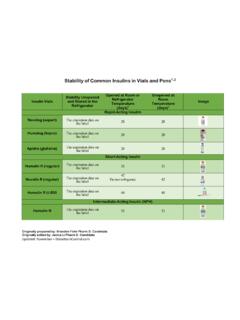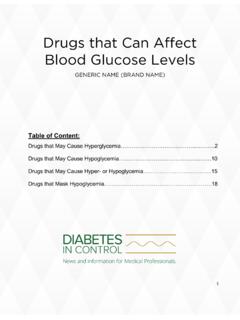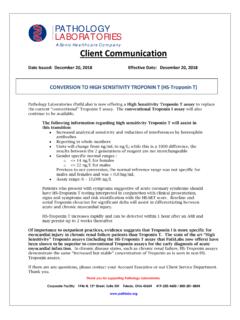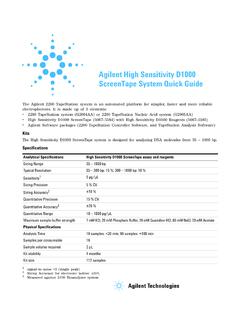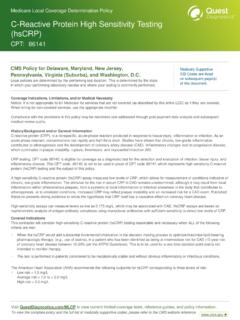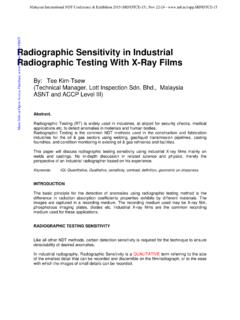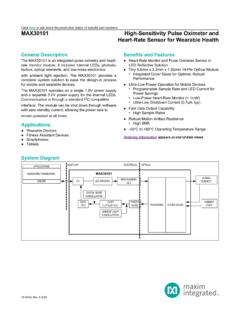Transcription of DETERMINING YOUR INSULIN SENSITIVITY FACTOR
1 DETERMINING your INSULIN SENSITIVITY FACTOR your INSULIN SENSITIVITY FACTOR , sometimes referred to as your correction FACTOR or correction bolus, is the mg/dl drop in your blood glucose caused by 1 unit of INSULIN . There will be times when you need to make INSULIN adjustments to keep your blood glucose within target. Sometimes, you will need to add more INSULIN at a mealtime to correct for a high blood glucose. Other times, you may want to correct a high blood glucose outside of a meal time. In either case, you ll need to know how many mg/dl one unit of INSULIN lowers your blood glucose level. The right correction bolus will return your blood glucose to within 30 mg/dl of your target blood glucose about 3 hours after you ve given the dose. Keep in mind that your SENSITIVITY FACTOR may vary throughout the day or during times of illness.
2 CALCULATING your SENSITIVITY FACTOR /CORRECTION FACTOR Total amount of INSULIN per day: (use a three day average) Basal daily total: _____units + Bolus daily total: _____units + Total Daily INSULIN : _____units Divide: 1700 by Total Daily INSULIN . This is your SENSITIVITY FACTOR /Correction FACTOR . Example: 14 units basal INSULIN + 16 units bolus INSULIN = 30 units total daily INSULIN 1700/30 = 50. This Correction FACTOR means that 1 unit of INSULIN will lower blood glucose by approximately 50mg/dl. HOW TO USE THE CORRECTION FACTOR TO CALCULATE A CORRECTION BOLUS: Correction Bolus Formula: (Current BG) - (Target BG) = Correction bolus dose (Correction FACTOR ) Example: Current BG = 200 mg/dl Target BG = 100 mg/dl Correction = 50 So, 200-100 = units of INSULIN for a Correction dose 50 TESTING your SENSITIVITY FACTOR /CORRECTION FACTOR Choose a time to test when.
3 your blood glucose value is at least 50 mg/dl above your target You have not taken a meal bolus or correction bolus for at least 4 hours You have not eaten any food for the last 4 hours You can go without eating for the next 4 hours Don t test your correction FACTOR during any circumstances that might affect the results, such as: After performing strenuous exercise If you have an illness or infection After a serious low blood glucose During major emotional stress Here are the steps to follow to test your Correction FACTOR : 1. Check and record your blood glucose 2. Take a correction bolus based on your current SENSITIVITY FACTOR /correction FACTOR 3. Test your blood glucose at 2, 3 and 4 hours after taking the bolus. Record your blood glucose values at these times: your blood glucose values should be going down If you drop below 70 mg/dl at any time during the test, treat the low and stop the test.
4 You will want to consult with your healthcare provider about an adjustment in your correction FACTOR (you may need less INSULIN ) 4. If your blood glucose is within 30mg/dl of your target blood glucose 4 hours after the dose, try using this same correction FACTOR again to confirm that it is correct. If your blood glucose is > 30 mg/dl of your target blood glucose 4 hours after the dose, repeat the test again with a smaller INSULIN SENSITIVITY FACTOR /correction FACTOR . If your blood glucose is < 30 mg/dl of your target blood glucose 4 hours after the dose, repeat the test again with a larger INSULIN SENSITIVITY FACTOR /correction FACTOR . 5. Repeat this test until you have determined your SENSITIVITY FACTOR /correction FACTOR and then repeat it one more time to confirm the results.
5 The worksheet on the next page may help you to do this testing. Courtesy of 11/22/09

